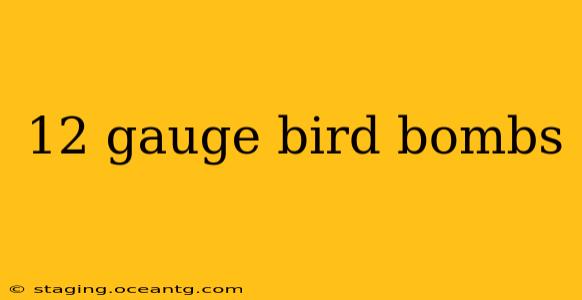Choosing the right ammunition is crucial for a successful bird hunting trip. The 12 gauge remains the most popular shotgun gauge for bird hunting due to its versatility and readily available ammunition. This guide delves into the specifics of 12 gauge birdshot shells, helping you understand the various options and choose the best one for your needs.
What Makes a Good 12 Gauge Birdshot Shell?
Several factors contribute to a high-performing 12 gauge birdshot shell for bird hunting. These include:
-
Shot Size: This refers to the diameter of the individual pellets. Smaller shot sizes (like No. 7½ or No. 8) are ideal for smaller birds like doves and quail, offering a wider spread and increased lethality at closer ranges. Larger shot sizes (like No. 4 or No. 6) are better for larger game birds, offering greater stopping power at longer ranges. The choice depends heavily on the bird species you're targeting and the distance you'll be shooting.
-
Shot Type: While lead shot remains common, many hunters now use steel, bismuth, or other non-toxic shot alternatives. These are often required by law in certain areas or for specific migratory birds. Steel shot, for instance, is harder and less likely to deform upon impact, maintaining its pattern better at longer ranges. However, it's generally harder on barrels and can have a different pattern compared to lead.
-
Shot Load: The amount of shot in the shell (measured in ounces) impacts the density of the pattern and range. Higher shot loads provide more pellets and hence greater stopping power, but also increase recoil.
What are the Different Types of 12 Gauge Birdshot Shells?
12 gauge birdshot shells come in a vast array of configurations, catering to different hunting styles and bird species:
-
High-Velocity Shells: Designed for longer ranges, these shells deliver the shot with higher muzzle velocity. This is useful for hunting fast-flying birds or shooting at greater distances.
-
Standard Velocity Shells: A good balance between velocity and recoil, standard velocity shells are versatile and suitable for various hunting situations. They offer a good compromise between range and pattern density.
-
Improved Cylinder Choke: This choke offers the widest pattern spread, making it ideal for close-range shots at smaller, faster birds.
-
Modified Choke: A balanced choke offering a good compromise between range and pattern density, it is a popular all-around choice for bird hunting.
What is the Best Shot Size for Different Birds?
The ideal shot size depends heavily on the bird species and the shooting distance. As a general guide:
- Doves and Quail: No. 7½ or No. 8 shot.
- Pheasants and Grouse: No. 6 or No. 4 shot.
- Ducks and Geese: Larger shot sizes (No. 2, No. 1, or BB) are usually necessary.
What are the Different Choke Tubes for 12 Gauge Shotguns?
Choke tubes significantly influence shot pattern and range. Different chokes constrict the shot as it exits the barrel, affecting the shot pattern:
- Improved Cylinder: Widest pattern, best for close-range shooting.
- Modified: A good all-around choice, providing a balance between range and pattern density.
- Full: Tightest pattern, maximizing range but reducing pattern spread.
What is the Best 12 Gauge Birdshot Shell for Beginners?
For beginners, a standard-velocity 12 gauge shell with No. 6 or No. 7½ shot and a modified choke is often recommended. This combination offers a good balance of range, pattern density, and manageable recoil. Focus on proper shooting techniques before venturing into more specialized ammunition.
This guide provides a basic understanding of 12 gauge birdshot shells. Remember to always consult your local regulations regarding the use of shot types and sizes for different game birds. Safe and responsible hunting practices are paramount.
